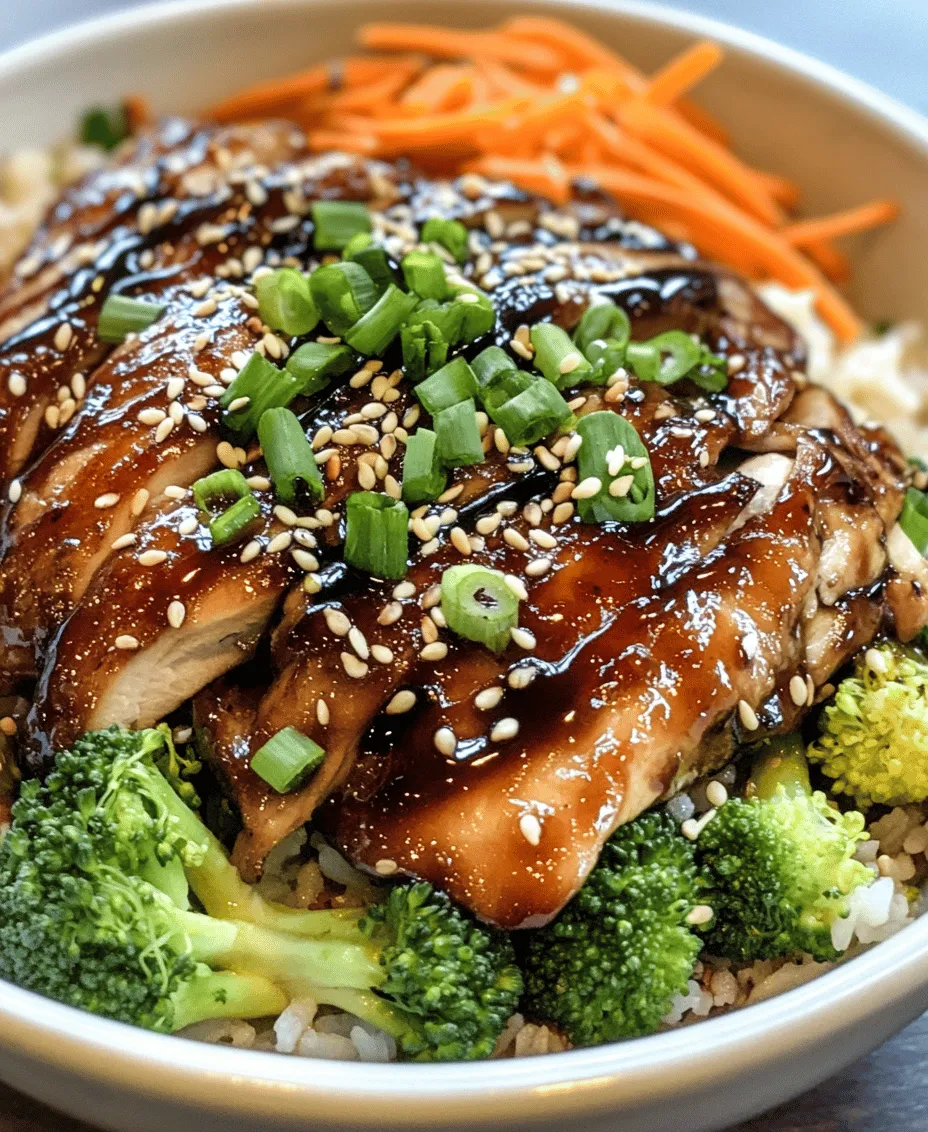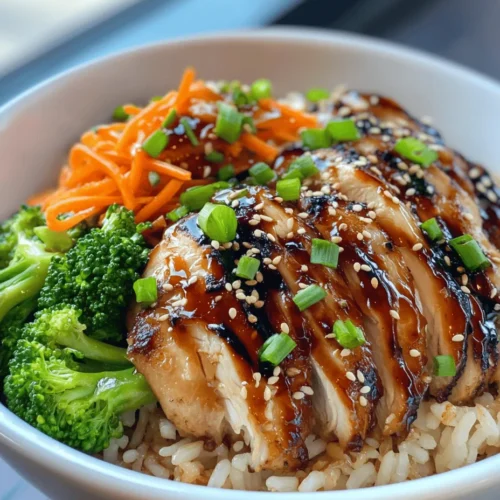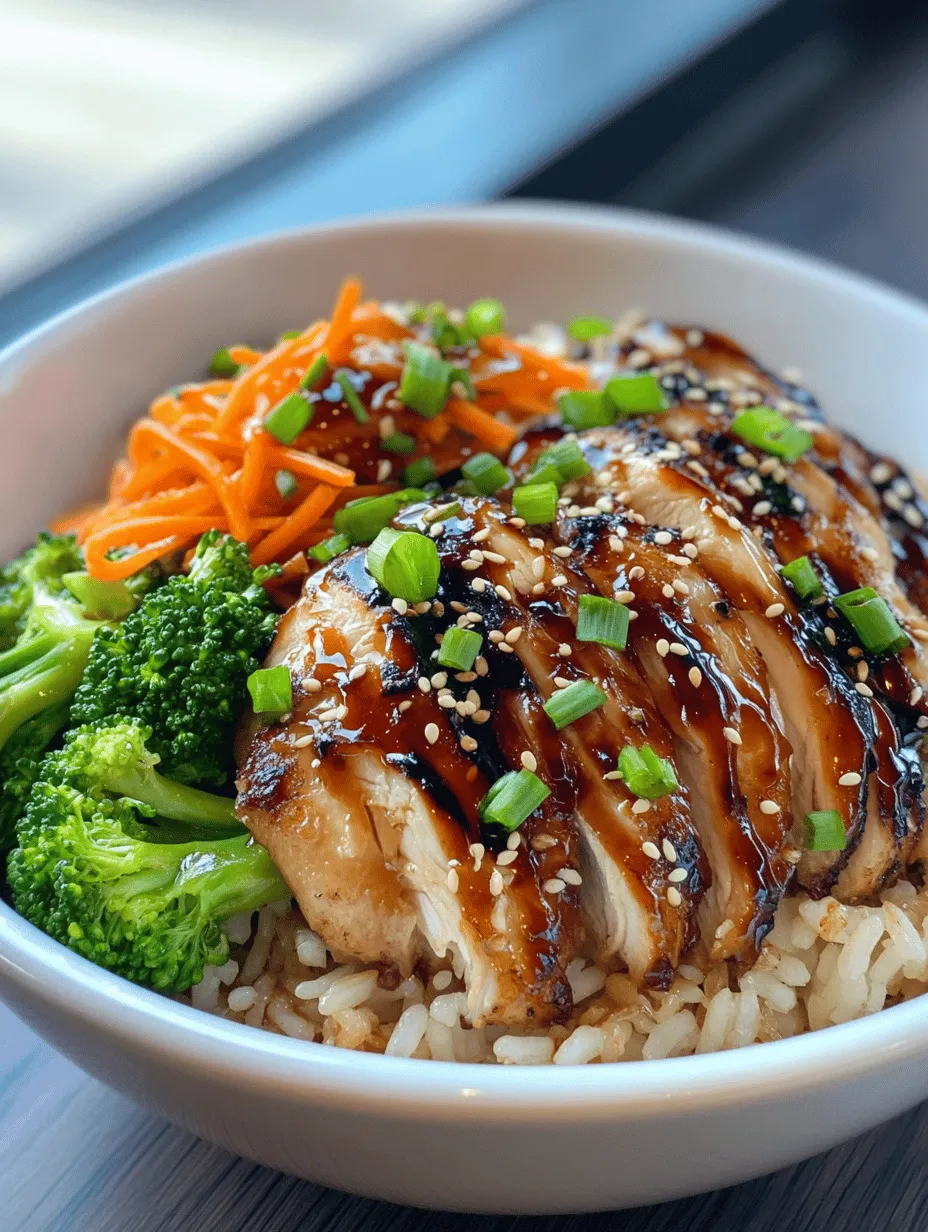Introduction
The Teriyaki Chicken Rice Bowl is a beloved staple in Japanese cuisine, known for its delightful combination of sweet and savory flavors, tender chicken, and perfectly cooked rice. This dish has garnered a significant following not only in Japan but across the globe, becoming a favorite in many households. The beauty of preparing this dish at home lies in the opportunity to cultivate culinary skills while enjoying a meal that’s both wholesome and satisfying.
In a world increasingly leaning towards fast food and pre-packaged meals, cooking at home allows individuals to control the quality of ingredients and tailor flavors to personal preferences. The Teriyaki Chicken Rice Bowl exemplifies this notion, as it brings together the natural sweetness of the marinade, the savory notes of soy sauce, and the freshness of vegetables, creating a balanced dish that appeals to both adults and children alike. The combination of tender chicken, fluffy rice, and vibrant vegetables makes it an ideal family meal, ensuring everyone at the table can enjoy a hearty and nutritious dish.
Understanding Teriyaki: A Cultural Context
To appreciate the Teriyaki Chicken Rice Bowl fully, it is essential to delve into the cultural roots of teriyaki itself. The term “teriyaki” originates from the Japanese words “teri,” meaning glaze, and “yaki,” meaning to grill or broil. This cooking method involves grilling meat or fish that has been marinated in a mixture containing soy sauce, mirin (a sweet rice wine), and sugar or honey, which creates a glossy, caramelized exterior. Traditionally, teriyaki is not just a cooking style but rather a way to enhance the natural flavors of the main ingredient, allowing the sweetness of the marinade to complement the savory notes of the protein.
The history of teriyaki dates back to the Edo period in Japan (1603-1868), where it first emerged as a popular method of preparing fish. Over the years, teriyaki has evolved, with chicken becoming one of the most popular proteins used in this style of cooking. The dish has transcended its cultural origins and adapted to various culinary landscapes worldwide, appearing on menus in restaurants and homes alike. Its versatility and adaptability have solidified its place in both Japanese cuisine and international gastronomy.
Ingredients Breakdown
Creating a delicious Teriyaki Chicken Rice Bowl requires a careful selection of ingredients, each playing a crucial role in achieving the dish’s hallmark flavors and textures. Here’s a closer look at the essential components:
Boneless, Skinless Chicken
This recipe primarily uses boneless, skinless chicken thighs or breasts. Chicken thighs are preferred for their juiciness and flavor, while breasts offer a leaner option. The absence of bones and skin not only makes preparation easier but also allows the marinade to penetrate the meat effectively, resulting in a tender and flavorful dish.
Jasmine Rice
Jasmine rice is favored for this rice bowl due to its fragrant aroma and slightly sticky texture, which holds up well when combined with the teriyaki sauce. This long-grain rice variety is known for its softness and ability to absorb flavors, making it an excellent base for the savory chicken and sauce.
Soy Sauce, Mirin, and Honey
The teriyaki sauce is the heart of the dish, and its preparation relies on a harmonious blend of soy sauce, mirin, and honey. Soy sauce provides the umami depth that is characteristic of many Asian dishes, while mirin introduces a subtle sweetness and complexity. Honey, or sometimes brown sugar, amplifies the sweetness, creating a glaze that caramelizes beautifully when cooked, enhancing the overall flavor profile.
Sesame Oil
A drizzle of sesame oil adds a distinctive nutty aroma and richness to the dish. This oil is often used in Asian cooking and complements the marinades and sauces beautifully, enhancing the overall depth of flavor in the Teriyaki Chicken Rice Bowl.
Fresh Ingredients
In addition to the main components, incorporating fresh ingredients like ginger, garlic, broccoli, and carrots elevates the dish’s nutritional value and flavor. Ginger and garlic contribute aromatic warmth, while broccoli and carrots add vibrant color and crunch, making the dish visually appealing as well as healthy.
Preparation Steps: A Guide to Perfecting Your Teriyaki Chicken Rice Bowl
As we embark on the cooking journey to create the perfect Teriyaki Chicken Rice Bowl, it is essential to follow a series of preparation steps that ensure each element of the dish is executed flawlessly.
Marinating the Chicken
One of the key steps in achieving a flavorful Teriyaki Chicken Rice Bowl is marinating the chicken. Marination is important as it allows the flavors to infuse into the meat, resulting in a tender and flavorful final product.
Recommended Marination Time and Temperature:
For optimal results, it is recommended to marinate the chicken for at least 30 minutes to 1 hour in the refrigerator. However, for those who have more time, marinating overnight will enhance the flavor even further. Ensure the chicken is coated evenly in the marinade to absorb the flavors fully.
Cooking the Rice
While the chicken marinates, it’s the perfect time to prepare the jasmine rice. Cooking rice may seem straightforward, but there are techniques that can help achieve the perfect, fluffy texture.
The Rinsing Process:
Start by measuring out the desired amount of jasmine rice. Rinse the rice under cold water in a fine-mesh strainer until the water runs clear. This rinsing process is crucial, as it removes excess starch that can lead to gummy rice.
Once rinsed, combine the rice with water in a pot, typically using a 1:1.5 ratio of rice to water for jasmine rice. Bring the mixture to a boil, then reduce heat to low, cover, and let it simmer for about 15 minutes or until the water is absorbed. Once cooked, fluff the rice with a fork to separate the grains, preparing a perfect base for the teriyaki chicken.
With these foundational steps, you are well on your way to creating a delicious Teriyaki Chicken Rice Bowl that encapsulates the essence of Japanese cuisine. The next phases will involve cooking the chicken and assembling the bowl, bringing together the aromatic ingredients for a culinary experience that is sure to delight.

Cooking the Chicken: Tips for Achieving the Perfect Texture and Flavor
To create a mouthwatering Teriyaki Chicken Rice Bowl, the chicken must be tender and flavorful. Begin with boneless, skinless chicken thighs for a juicier result, though chicken breasts can also be used for a leaner option.
Cooking Times and Temperature Considerations
Cook the chicken over medium-high heat to ensure an even sear and to lock in juices. For chicken thighs, cook them for about 6-7 minutes on each side, until they reach an internal temperature of 165°F (75°C). If using chicken breasts, they may take slightly less time, around 5-6 minutes per side, depending on thickness.
Utilizing a meat thermometer is crucial; it guarantees that your chicken is cooked through while preventing it from drying out. Searing the chicken for the first couple of minutes helps develop a golden-brown crust, contributing to the dish’s overall flavor profile.
Preparing the Teriyaki Sauce: Step-by-Step on Thickening and Flavor Balancing
The teriyaki sauce is where the magic happens in this dish. To make your sauce, begin by combining the reserved marinade and additional ingredients in a small saucepan over medium heat. This reserved marinade is essential; it not only enhances the flavor but also adds depth to the sauce.
Step-by-Step Instructions for Sauce Preparation
1. Combine Ingredients: In a saucepan, mix the reserved marinade with an equal part of water and a tablespoon of cornstarch to aid thickening.
2. Heat: Bring this mixture to a gentle boil over medium heat, stirring frequently to avoid lumps.
3. Thicken: Allow the sauce to simmer for about 3-5 minutes until it thickens to a syrupy consistency. If it becomes too thick, add a bit more water until you reach your desired texture.
4. Flavor Balance: Taste the sauce; it should be a harmonious blend of sweet and savory. Adjust by adding more soy sauce for saltiness or honey for sweetness, as per your preference.
Importance of Using the Reserved Marinade for Sauce Development
Using the reserved marinade not only enhances the flavor but also minimizes waste, allowing you to enjoy every bit of the flavorful ingredients you’ve prepared. This technique ensures that the flavors of the chicken and sauce meld beautifully, creating a cohesive taste experience.
Assembling the Bowl: Aesthetic Presentation Tips for a Mouthwatering Dish
Presentation is key when it comes to enjoying your Teriyaki Chicken Rice Bowl. A well-assembled bowl not only looks appetizing but also enhances the dining experience.
Layering Ingredients for Visual Appeal and Flavor Distribution
1. Base Layer: Start with a generous scoop of steamed white or brown rice at the bottom of your bowl. This serves as the base and absorbs the flavors of the sauce.
2. Chicken Placement: Slice the cooked chicken into strips and arrange them neatly on one side of the rice.
3. Vegetable Arrangement: Add your choice of steamed vegetables—broccoli, snap peas, or bell peppers—on the other side of the rice, providing a colorful contrast.
4. Sauce Drizzle: Generously drizzle the thickened teriyaki sauce over the chicken and rice, allowing it to cascade down the sides for a visually appealing effect.
Garnishing: The Role of Green Onions and Sesame Seeds in Enhancing Flavor and Presentation
A well-garnished dish elevates the overall flavor and visual appeal. Sprinkle chopped green onions and toasted sesame seeds over the top for a burst of color and crunch. Green onions add a fresh, oniony flavor that complements the sweetness of the teriyaki sauce, while sesame seeds introduce a nutty richness.
Nutritional Analysis of the Teriyaki Chicken Rice Bowl
Understanding the nutritional profile of your dish can help you appreciate the benefits of each ingredient.
Breakdown of Calories, Macronutrients, and Micronutrients
A typical serving of Teriyaki Chicken Rice Bowl contains approximately:
– Calories: 450-600 (depending on portion size)
– Protein: 30-35g
– Carbohydrates: 60-70g
– Fats: 10-15g
Micronutrients: The bowl is rich in vitamins and minerals, particularly if you include colorful vegetables. For instance, broccoli provides vitamin C, potassium, and fiber, while sesame seeds add calcium and magnesium.
Health Benefits of Key Ingredients
– Chicken: A high-quality protein source that supports muscle growth and repair.
– Broccoli: Known as a superfood, it’s packed with vitamins K and C, fiber, and antioxidants.
– Rice: A good source of carbs that provides energy, especially important for active lifestyles.
Comparison to Store-Bought Alternatives in Terms of Healthiness
Homemade Teriyaki Chicken Rice Bowls are considerably healthier than many takeout options. Store-bought versions often contain added sugars, preservatives, and unhealthy fats. By making it at home, you control the ingredients and can significantly reduce sodium levels and unhealthy additives.
Variations and Customizations
One of the beauties of the Teriyaki Chicken Rice Bowl is its versatility. Here are some ideas for customization:
Suggestions for Ingredient Substitutions
– Tofu: For a vegetarian or vegan option, substitute chicken with firm tofu, marinated and pan-fried until golden.
– Quinoa or Cauliflower Rice: For a low-carb alternative, consider using quinoa or cauliflower rice as the base.
Seasonal Variations
Incorporate seasonal vegetables like asparagus in spring, zucchini in summer, or root vegetables in fall to keep the dish fresh and exciting year-round.
Flavor Adjustments
For those who enjoy a bit of heat, add chili flakes or Sriracha to the teriyaki sauce. Alternatively, you could opt for a sweeter profile by incorporating pineapple juice into the marinade for a tropical twist.
Serving Suggestions
Teriyaki Chicken Rice Bowls are incredibly versatile and suitable for various occasions.
Ideal Occasions for Serving
This dish is perfect for family dinners, meal prepping for the week, or even serving at gatherings where you want to impress guests with a homemade meal.
Pairing Ideas
Complement your bowl with a light cucumber salad, miso soup, or steamed edamame. For beverages, consider pairing with green tea or a light Japanese lager to enhance the overall dining experience.
Conclusion
Creating a homemade Teriyaki Chicken Rice Bowl is not only a satisfying culinary adventure but also a rewarding way to enjoy a delicious, healthy meal. This dish’s versatility allows you to cater to various dietary preferences, making it accessible to everyone at the table.
Encourage yourself to experiment with the ingredients and customize this recipe to suit your taste. Whether you’re enjoying a cozy family dinner or meal prepping for the week, the Teriyaki Chicken Rice Bowl is sure to become a beloved staple in your kitchen. So gather your ingredients, unleash your creativity, and savor the joy of cooking!



